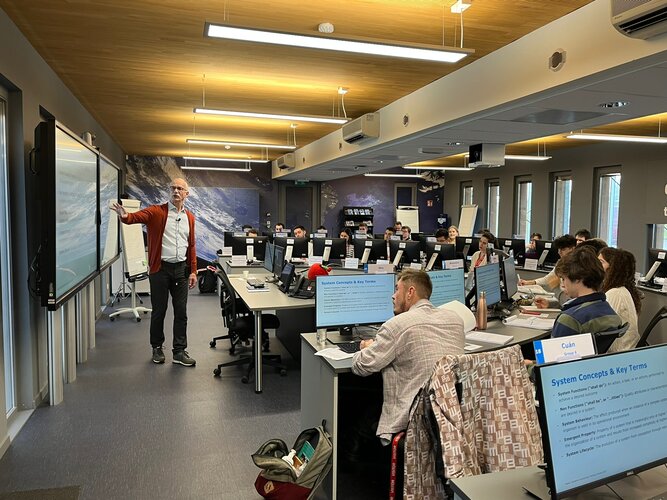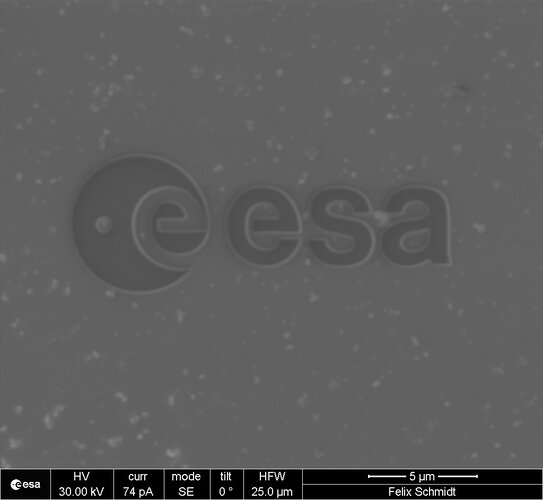First ever ESA Academy Navigation Training Course!
Friday, 24 March 2023 14:13
For the first time ever, ESA Academy is opening a call for university students to apply for the pilot edition of the Navigation Training Course, to be held from 26 to 30 June 2023 at ESA Academy’s Training and Learning Facility in ESEC-Galaxia, Belgium. This Training Course has been developed by ESA Education and ESA’s Directorate of Navigation. Would you like to know more about the future of satellite navigation? Apply for our course today!
Week in images: 20-24 March 2023
Friday, 24 March 2023 13:43
Week in images: 20-24 March 2023
Discover our week through the lens
China loses UAE as partner for Chang’e-7 lunar south pole mission
Friday, 24 March 2023 11:48
An agreement for a United Arab Emirates’ rover to fly on China’s Chang’e-7 lunar mission has apparently been hit by U.S.
Advisory group backs European human spaceflight program using commercial approaches
Friday, 24 March 2023 11:20
An advisory committee called on the European Space Agency to develop a comprehensive human spaceflight program using a more commercial approach.
Lockheed Martin launches commercial ground control software for satellite constellations
Friday, 24 March 2023 09:32 To help future developers of commercial satellite constellations plan missions and operate their systems, Lockheed Martin (NYSE: LMT) is now offering commercial licenses to its proven Horizon Command and Control (C2) and Compass Mission Planning software.
Horizon and Compass leverage an integrated and scalable modular architecture designed to meet specific customer needs. They provide miss
To help future developers of commercial satellite constellations plan missions and operate their systems, Lockheed Martin (NYSE: LMT) is now offering commercial licenses to its proven Horizon Command and Control (C2) and Compass Mission Planning software.
Horizon and Compass leverage an integrated and scalable modular architecture designed to meet specific customer needs. They provide miss Oversight Program aims to make space domain more tactically relevant for military planners, warfighters
Friday, 24 March 2023 09:32 DARPA aims to help military planners keep track of up to 1,000 targets of interest through management of available space domain resources. The goal of the Oversight program is to enable constant custody to maintain tracking of targets of interest for tactical missions. Apogee Research LLC, BAE Systems Information and Electronics Systems Integration Inc., and Systems and Technology Research LLC a
DARPA aims to help military planners keep track of up to 1,000 targets of interest through management of available space domain resources. The goal of the Oversight program is to enable constant custody to maintain tracking of targets of interest for tactical missions. Apogee Research LLC, BAE Systems Information and Electronics Systems Integration Inc., and Systems and Technology Research LLC a USSF announces university opportunities Beyond GEO operations
Friday, 24 March 2023 09:32 In partnership with the Air Force Research Laboratory and Universities Space Research Association, the United States Space Force announced the establishment of a new University Consortium Research Opportunity addressing space science and technology challenges today.
The research focus areas for this UCRO will include Beyond Geostationary Earth Orbit (xGEO) Operations and Space Domain Aware
In partnership with the Air Force Research Laboratory and Universities Space Research Association, the United States Space Force announced the establishment of a new University Consortium Research Opportunity addressing space science and technology challenges today.
The research focus areas for this UCRO will include Beyond Geostationary Earth Orbit (xGEO) Operations and Space Domain Aware Inmarsat and RBC Signals complete live testing of dynamic spectrum leasing solution
Friday, 24 March 2023 09:32 Inmarsat, a world leader in global, mobile satellite communications, has announced that RBC Signals will be the first partner to resell its innovative IoT Connectivity Leasing solution. The agreement follows the successful testing of the solution, which enables the dynamic provision of satellite connectivity depending on changing customer needs.
The proposition will enable customers of RBC
Inmarsat, a world leader in global, mobile satellite communications, has announced that RBC Signals will be the first partner to resell its innovative IoT Connectivity Leasing solution. The agreement follows the successful testing of the solution, which enables the dynamic provision of satellite connectivity depending on changing customer needs.
The proposition will enable customers of RBC Where did Earth's water come from? Not melted meteorites, say scientists
Friday, 24 March 2023 09:32 Water makes up 71% of Earth's surface, but no one knows how or when such massive quantities of water arrived on Earth.
A new study published in the journal Nature brings scientists one step closer to answering that question. Led by University of Maryland Assistant Professor of Geology Megan Newcombe, researchers analyzed melted meteorites that had been floating around in space since the so
Water makes up 71% of Earth's surface, but no one knows how or when such massive quantities of water arrived on Earth.
A new study published in the journal Nature brings scientists one step closer to answering that question. Led by University of Maryland Assistant Professor of Geology Megan Newcombe, researchers analyzed melted meteorites that had been floating around in space since the so Astronomy instrument helps capture singular quantum interference effects
Friday, 24 March 2023 09:32 By adapting technology used for gamma-ray astronomy, a group of experimental researchers has found that X-ray transitions previously thought to have been unpolarized according to atomic physics, are in fact highly polarized, reports a new study published in Physical Review Letters on 15 March.
When electrons recombine with highly charged ions, X-ray polarization becomes important for testi
By adapting technology used for gamma-ray astronomy, a group of experimental researchers has found that X-ray transitions previously thought to have been unpolarized according to atomic physics, are in fact highly polarized, reports a new study published in Physical Review Letters on 15 March.
When electrons recombine with highly charged ions, X-ray polarization becomes important for testi Sierra Space advances to the forefront of commercial and national security policy in the Orbital Age
Friday, 24 March 2023 09:32 Sierra Space, a leading, pureplay commercial space company building the first end-to-end business and technology platform in space, has announced the creation of a new strategy and government affairs group that positions the company for long-term success and growth in the Orbital Age.
To lead this dynamic new organization, Sierra Space recruited one of Washington, D.C.'s most prominent and
Sierra Space, a leading, pureplay commercial space company building the first end-to-end business and technology platform in space, has announced the creation of a new strategy and government affairs group that positions the company for long-term success and growth in the Orbital Age.
To lead this dynamic new organization, Sierra Space recruited one of Washington, D.C.'s most prominent and Neuraspace introduces "Machine Learning Prediction Plots" for earlier debris planning
Friday, 24 March 2023 09:32 Neuraspace, a European-born global leader in space traffic management (STM), has introduced "Machine Learning Prediction Plots", giving satellite and satellite constellation operators a tool for earlier collision avoidance planning.
As a first in the space industry, the latest addition to Neuraspace's STM software, using artificial intelligence (AI), enables operators to decide several day
Neuraspace, a European-born global leader in space traffic management (STM), has introduced "Machine Learning Prediction Plots", giving satellite and satellite constellation operators a tool for earlier collision avoidance planning.
As a first in the space industry, the latest addition to Neuraspace's STM software, using artificial intelligence (AI), enables operators to decide several day TDGA secures New Media Holding as lead investor in $20M seed round for Space Media
Friday, 24 March 2023 09:32 London based TDGA, the owner of the biggest brand in Space Media today, Space Hero, announced a $20m Seed Round. As part of the round, Singapore based New Media Holding, owner of the World's largest Creator network and Asia's largest media network, has invested $5m as a strategic investment. Furthermore, NMH has committed to be the lead investor for this round after an extensive due diligence va
London based TDGA, the owner of the biggest brand in Space Media today, Space Hero, announced a $20m Seed Round. As part of the round, Singapore based New Media Holding, owner of the World's largest Creator network and Asia's largest media network, has invested $5m as a strategic investment. Furthermore, NMH has committed to be the lead investor for this round after an extensive due diligence va Ultrafast beam-steering breakthrough at Sandia Labs
Friday, 24 March 2023 09:32 In a major breakthrough in the fields of nanophotonics and ultrafast optics, a Sandia National Laboratories research team has demonstrated the ability to dynamically steer light pulses from conventional, so-called incoherent light sources.
This ability to control light using a semiconductor device could allow low-power, relatively inexpensive sources like LEDs or flashlight bulbs to replac
In a major breakthrough in the fields of nanophotonics and ultrafast optics, a Sandia National Laboratories research team has demonstrated the ability to dynamically steer light pulses from conventional, so-called incoherent light sources.
This ability to control light using a semiconductor device could allow low-power, relatively inexpensive sources like LEDs or flashlight bulbs to replac 

 Image:
ESA in miniature
Image:
ESA in miniature